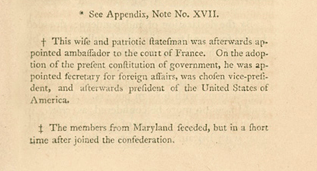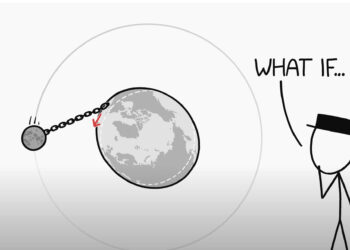
The humble footnote, seemingly the province of scholars, plays an important role beyond the world of scholarly expertise. Scholarship, no matter the discipline, is about the productive and persuasive relationship of evidence to argument. Whereas opinion requires thought (more or less), scholarship requires evidence. A scholar accumulates evidence, in a lab or in an archive or through another method, and presents a conclusion based on same. The reader is offered both evidence and argument in order to assess how well the first supports the second. For a specialist reader the evidence is more easily assessed, but for the non-specialist the footnote is a signal that the evidence could be sourced to its roots in that lab, archive, or dataset. Could you put nonsense in a footnote? Sure. But the footnote at least gestures to the obligation of providing evidence for assertions and conclusions.
How can this be as consequential as my title suggests?
Early in the American experiment political leaders recognized that, unlike monarchy, republics require an educated citizenry. Alan Taylor, Pulitzer prize winner (twice!) and Thomas Jefferson Foundation Professor of History at the University of Virginia, wrote in September about why the significance of the founding generation’s commitment to education remains relevant. As Taylor noted, Jefferson himself argued that “Ignorance and despotism seem made for each other.” Plans for expanding educational opportunities and institutions ran afoul of a largely uneducated populace unwilling to make the required investments. But by fits and starts, and with the greatest boost coming in the twentieth century, American education grew; the United States can now boast of the largest percentage of college graduates in the world.
Yet media analyses are now also full of angst about the information ocean through which consumers must swim and remorse about the resulting “post-fact world.” Farhad Majoo argued most explicitly that “the internet is distorting our collective grasp on the truth.” Author of True Enough: Learning to Live in a Post-Fact Society (2008), Majoo observes eight years on an ever-accelerating trend toward disinformation and conspiracy-mindedness. The convergence of confirmation bias and a proliferating punditry (in place of reporting) has left readers, watchers, and internet searchers with fewer opportunities for critically consuming information in the fashion we have long fantasized that an engaged citizenry would do.
I have concerns about Open Access (OA), and OA business models as potentially undermining the very scholarship we seek to share more widely. But I absolutely share the conviction that scholarship is too important not to be shared as widely as possible. It may be more critical, though, to share the process of scholarly production. No matter the discipline, we need to be as open and as articulate about what makes for good scholarship as we are about the specific scholarly problems with which we’re engaged.
Thus, the footnote. I am an unabashed lover of footnotes. I happily read them in tandem with text in the main body of a book or article. When done well, notes and text speak together, evidence and argument united in the work of knowledge creation in a way neither could effect on their own. Notes do different kinds of work — some are citations of sources for the argument or assertion in the text, some of references to secondary literature in support of a claim, some are citations to secondary sources that make similar or dissimilar claims. And discursive notes might frame a problem in terms of the developing literature or gesture at a methodological issue or briefly elaborate a point made in the text.
It’s not easy to find footnotes to love anymore. As a historian I’m diehard Chicago Manual of Style; other disciplines have different referencing conventions and it’s important to read across disciplines. Although many journals, whatever the discipline, still use footnotes, most history books – at least on my shelves and desk — now have endnotes. The argument is that publishers prefer endnotes because of the modest cost-savings (in typesetting, even with newer technology, also in paper because endnotes save pages), but also because of the notion that the elusive general reader may be put off by the explicitly scholarly scaffolding implied by footnotes.
The cost issue has to be respected, or at least accounted for, but the notion that general readers can not or will not engage with notes makes too neat a distinction between scholarly readers and general readers (neither of whom we really have enough information about). Some scholars prefer a narrative unencumbered by notes, or simply the aesthetics of the uncluttered page. Some general readers who like to see the sources may find flipping back and forth a hassle. Let’s not even think about the separate online go-look-for-it-if-you-really-care notes. Although perhaps we ought to be thinking a lot more carefully about the e-book platforms that so cruelly separate chapters and from notes, making navigation to an endnote at best a challenge. Scholarly readers and the engaged public alike can appreciate not only the source of a scholarly argument, but the process of the argument’s evolution. This capacity for appreciation is not a generalizable skill in the way that humanists are now discussing teaching critical thinking skills; it is a practice. It is a practice that is useful, interesting, and important. It is the difference between strong science and defunding scientific inquiry. It is the difference between debating good governance and crass politicization.
Eminent historian of books and reading Anthony Grafton’s appropriately quirky The Footnote* A Curious History recounts the complex ways that reference styles developed and redeveloped over centuries, through intellectual fashions and typographical technologies. Modern inheritors of citation practices of the eighteenth and nineteenth centuries, themselves the product of previous centuries of tradition and innovation, emphasized the importance of both craft and technique. For historians the footnote tells “the double story of the historical past and the historian’s research.” (67) Grafton’s tour concludes with the observation that reference systems are all fallible, but that the form itself is important. “Only the use of footnotes and the research techniques associated with them makes it possible to resist the efforts of modern governments, tyrannical and democratic alike, to conceal the compromises they have made, the deaths they have caused, the tortures they or their allies have inflicted.” (233)
Scholarship matters. It matters not only for the content, but for the process. We need to embrace that process, articulate that process, engage the public in that process. For me, it starts with footnotes.
Discussion
35 Thoughts on "Does Democracy Need Footnotes?"
Great post, Karin. I’d like to support your love of footnotes with my equal love of a good index. Too many books these days come out with shoddy or missing indices, yet a good index makes revisiting or rewinding a text possible in important ways. Just as footnotes allows layers to emerge, an index jogs your memory and makes old books relevant in an instant.
Just wanted to add that footnote.
YES! I find there are two kinds of people in the world–those who rely on tables of contents and those who use an index. Indexing does appear to be a slipping art. If there is an eBook version of a publication, it seems the index gets cut leaving the print readers in trouble. I also suspect that we are seeing indices deteriorate in quality because they are being done with programming and not human beings.
Kent & Angela–thanks for your defense of the index. I’ve heard scholars argue that with Google books and keyword searches, there’s no point in spending much money or time on an index. I can see that point, and I’ve readily used Google books for just that purpose.
In the end, I decided that making a good index was important for my latest book. It was being published in traditional material, codex form, and I wanted a buyer and/or reader to have a fully functional product in their hands without also needing a supplementary device. If we want people to continue reading books, then we need to make them as useful as possible on their own.
Ever since we solved the danger of fire 100+ years ago or so, paper has proved to be a strikingly endurable information storage medium. We don’t know what the long-term future of Google books might be, so why trust it to offer your readers full access to your work indefinitely?
Contra Majoo, everywhere I look (including here at TSK) I see people debating, confronting one another on complex issues. This often includes offering evidence and it is a huge step forward from stand alone text, even text with footnotes. In a way comments are themselves footnotes.
In at least some e-books clicking on the footnote superscript number automatically takes you to the footnote directly. Why is this format not universally adopted? It avoids a “cluttered page” while providing immediate and easy access to the notes along the way. An ideal solution, it seems to me. Is this more expensive in creating e-books than in keeping all notes separate from the text?
‘In at least some e-books clicking on the footnote superscript number automatically takes you to the footnote directly. Why is this format not universally adopted?’
I’ve generally been very disappointed with the poor in-text navigation options offered by many e-book platforms. I find that most of those I’ve used don’t allow me to click from the in-text reference to the notes (footnote or endnote). And as for the lack of linking from indexes to text, is that something that’s particularly difficult to achieve?
Those who complain about opinion’s triumph over facts are often the same people who think science is settled.
This is a thoughtful and timely post, Karin.
The information landscape that Manjoo wrote about a decade ago has come to pass, and then some. Maybe authors and editors can make the argument that the internet has made everything old new again w/r/t footnotes? That is, readers/viewers spend hours and hours on Facebook, which has a singularly ugly and unfriendly design. Twitter is much better, but still not great (and obvs. having its challenges now). How could a page with footnotes at the bottom be any more distracting or irritating than FB’s design, or than the autoplay ads and videos that have ruined the internet for me lately?
Clearly, consumers consume the information they want, regardless of design. Maybe writers and editors have been too modest about what they have to offer–a clean, well-lighted space in which a reader can learn and contemplate, and in a book with footnotes, can see the evidence for the ideas and claims in the text.
I’ve seen my students swing back around to using books rather than proprietary e-readers, tablets, or phones–and some are even printing articles out on PAPER because they find it’s a superior technology for learning and recalling information. Whodathunkit?
Thanks, too, to your other commenters here for a good discussion.
Thanks, Ann! I agree that a beautifully designed printed page has a lot going for it as opposed to the ad cluttered and usually really ill-designed space that is so much online reading. In particular (and I used to think this was generational, now I don’t) that page is good to think with whereas many online spaces are not.
I have not seen any evidence that “a beautifully designed printed page” is better when it comes to thinking. Do you nave a footnote reference for this very strong claim?
Are you seriously suggesting that design plays no role in reader comprehension?
If you’re looking for a bibliography, I can suggest Googling the last few hundred years of efforts to study typography, layout, design, etc., or at the very least perhaps you might read the works of Edward Tufte to get something of a handle on how the visual presentation of information affects reading and understanding.
I sem to have touched an interesting nerve. First of all, I distinguish thinking from comprehension. The Tufte work that I know of is about graphic design of complex displays and here design is certainly central when it comes to comprehension. But as for simple text, I have no trouble reading these coments. Moreover, when it comes to generating thinking, surely what is said is far more important than the typeface or page layout.
It’s less that you’ve “touched a nerve” than that you’ve said something ridiculous. There is an entire field with a lengthy history of research into efficiency and readability of design and how that design affects comprehension.
And yes, much of that work has studied “simple text”. Put that simple text into a low resolution font at the wrong size, cram it all into one narrow column with poor kerning, interrupt the text continuously with flashing advertisements, images and call-outs and your reading comprehension will drop.
I would suggest you start with the simplified explanations at Butterick’s Practical Typography (http://practicaltypography.com/), see a basic example here: https://www.propublica.org/article/how-typography-can-save-your-life , see an example from this very blog here: https://scholarlykitchen.sspnet.org/2012/08/13/the-typography-of-authority-do-fonts-affect-how-people-accept-information/ , or another here: https://scholarlykitchen.sspnet.org/2015/07/24/optical-illusions-legibility-and-how-to-choose-the-right-font/
If you need references proving the moon landing or that the earth is not flat, let us know.
You seem to have missed my point. The issue is thinking, not readability. I have in fact done research on readability, but even readability extends far beyond physical features. Are you familiar with the Flesch test? I got a federal executive order on the readability of regulations.
Obviously if one cannot read the words, that is a big problem. But beyond that, what they say is far more important than their physical design. Ideas are not based on typography.
And you seem to refuse to acknowledge what others are saying. Go take a look at Kent’s post here https://scholarlykitchen.sspnet.org/2012/08/13/the-typography-of-authority-do-fonts-affect-how-people-accept-information/ or the Errol Morris articles he cites http://opinionator.blogs.nytimes.com/2012/08/08/hear-all-ye-people-hearken-o-earth/?utm_source=slashdot&utm_medium=slashdot&utm_campaign=slashdot&_r=0 if you still think that typography does not inform comprehension and “thinking”.
I think we should stop educating Wojick about this . . . after all, it’s only because people don’t know the power of design that we can use it to full effect. He’s the perfect audience — susceptible but convinced he’s not!
Perhaps you can explain how the layout of this page affects my thinking. Keep in mind that thinking is my field.
I did not say that topography does not “inform” comprehension, whatever that means. My point is that it is a minor effect compared to what is said. Let us say that I read an article about quantum dots, or Jackson’s valley campaign, or whatever topic you choose. Certain thoughts occur to me on reading this material. Are you seriously claiming that what these thoughts are is significantly affected by the typeface the article is written in?
Are “thinking” and “comprehension” unrelated?
I don’t really have the time (nor the expertise) to offer you a full course in typography, layout and design, suffice to say that centuries’ worth of work is available on the subject if you would like to learn more.
Of course comprehension and thinking are related. Comprehension means understanding what is written. Thinking means adding new thoughts to that. My point is that typography and design have little to do with the latter. To paraphrase you, I don’t really have the time (but I do have the expertise) to offer you a full course in comprehension, understanding and thought, Suffice to say that thousands of years worth of work is available on the subject if you would like to learn more.
Being a great editor no more makes one an expert in thinking than being a great athlete makes one an expert in physiology.
Given that thinking on a subject requires comprehension, and that design plays a key role in comprehension, one would then conclude that design does have some influence on thinking. If you can’t understand the basic facts of a subject, or if you misunderstand them, that affects further thinking.
To paraphrase you, I don’t really have the time (but I do have the expertise) to offer you a full course in comprehension, understanding and thought, Suffice to say that thousands of years worth of work is available on the subject if you would like to learn more.
I’m not the one asking for further information on a subject nor denying the validity of a field of study.
Being a great editor no more makes one an expert in thinking than being a great athlete makes one an expert in physiology.
I’m not sure anyone is making this claim, although it does make for an excellent strawman. I would also add that claiming to be an expert in any subject does not make one an effective practitioner of that subject.
Like David and many other readers here, I could go on and on about how important the formatting of “simple text” is to comprehension, from reading speed to endurance (how long you can read at length). You can take the same text, set it in a slightly different font, with slightly different leading and line-lengths, and at a slightly different size, and dramatically improve reading speed, time on page, and comprehension. This is why page proofs are still so important to a good editorial process — authors and editors often see things when words are properly typeset that they couldn’t see beforehand.
So, yes, you said something demonstrably untrue and, for this audience, kind of laughable. Any professional publisher or editor worth her or his salt knows better.
“This is why page proofs are still so important to a good editorial process.” Can’t like this enough (if we still had the thumbs up button.)
Kent, you claim as follows: “You can take the same text, set it in a slightly different font, with slightly different leading and line-lengths, and at a slightly different size, and dramatically improve reading speed, time on page, and comprehension.”
Dramatically improve comprehension? I do not believe this.
People want information. Design is largely irrelevant compared to delivery.
To quote a thoughtful candidate from this election cycle, “Wrong.”
How so?
Let’s ride the opposite horn for a moment. Suppose that page design does influence thinking. The question then is what influence does the journal want to promote? The two obvious contenders are acceptance versus questioning. If the journal chooses to promote one of these modes of thinking, then it should it post a disclaimer to that effect, such as “Our page design is designed to promote a specific sort of thinking. Readers should be aware of this promotion.”
Or perhaps it is just thinking per se that design is intended to promote. The number of thoughts per page, as it were. Or perhaps more good thoughts, or interesting thoughts, or useful thoughts, whatever that means. How does this work?
Having spent the last 40+ years studying thinking, I find these vague claims to be seriously strange.
David W., You asked about how the layout of this page affects your thinking. It does in myriad ways. One obvious one is that the comments follow the article in discussion threads. The comments might instead be presented to the side of the article and be placed near a relevant passage (see for example how journals like JAMA or eLife display references). By placing the comments next to the article, there is a subtle (or perhaps not at all subtle) suggestion that they should be responding to specific points in the article. To place them below suggests that they might respond to the article more generally. To place them in threaded discussion suggests that there should be a discussion — as opposed to one-off comments. To have each comment in a discussion assigned less and less space the discussion thread continues says something about the prescribed nature of replies to comments. And so on. To the extent that one thinks before one comments (which I realize may be an option question when it comes to comments on the Internet), the layout of the commenting tools therefore can have a non-trivial influence on thinking. This is one example. Others include the size and placement of images, the size and placement of the author’s slug, the size and placement of a subtitle, and so on.



